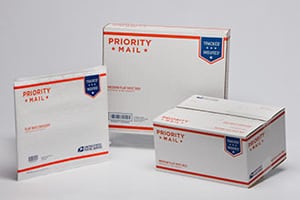 As it continues to battle UPS, FedEx and DHL for a larger slice of the ecommerce shipping pie, the U.S. Postal Service has put in a rate schedule request with the Postal Regulatory Commission that would keep its competitive Priority Mail rates unchanged for domestic delivery while raising the price of Parcel Select – the primary last-mile option of the major carriers – by an average of 8%.
As it continues to battle UPS, FedEx and DHL for a larger slice of the ecommerce shipping pie, the U.S. Postal Service has put in a rate schedule request with the Postal Regulatory Commission that would keep its competitive Priority Mail rates unchanged for domestic delivery while raising the price of Parcel Select – the primary last-mile option of the major carriers – by an average of 8%.
USPS’s Parcel Select service goes under the brand names FedEx SmartPost, UPS SurePost and DHL eCommerce (formerly Global Mail), which make up the majority of its volume.
The overall rate request from the USPS is for a 3.4% increase. If it’s approved, Priority Mail International will increase 6.8%, adding zone pricing in Canada, and Priority Mail Express International will increase 6.7% percent, with flat rate pricing available.
USPS told the PRC that if the rate changes are approved, they would result in an additional $310 million in revenue this year.
“This is a smart move,” said Rob Martinez, president and CEO of Shipware. “The USPS’s 2014 pricing didn’t take effect until late in the year (September), and as many shippers continue to evaluate postal rates into 2015, pricing stability enables ongoing comparison with FedEx and UPS.”
The strategy appears to be working, as the USPS said its shipping and package services volume grew by 300 million pieces in 2014, an increase of 8.1%.
Martinez added that many shippers “have not yet gotten their arms around” the impact of just-instituted FedEx and UPS dimensional pricing. He said this plays favorably for the USPS, as it again reiterated with the rate request that it didn’t plan to introduce DIM.
Under dimensional pricing, parcels are priced based on volume as well as weight. This move was driven by the fact that many ecommerce orders resulted in smaller items being packed in large boxes, thus quickly filling up delivery trucks well before they hit their weight limits.
Paul Steiner, vice president of strategic analysis for consultancy Spend Management Experts, said improvements in tracking, insurance coverage and guaranteed delivery, coupled with reduced commercial rates in 2014 helped spur this growth.
“Priority Mail is now seen as a competitive solution to UPS and FedEx ground services since parcels are delivered within two to three days anywhere in the U.S.,” Steiner said. “The rates in many cases are better, especially for the longer zones.”
“This is very clever on the part of the USPS,” said shipping and logistics consultant Jerry Hempstead. “I’m surprised they hadn’t done it sooner. I was also surprised by their statement in the fall that they were actually lowering Priority Mail prices. It didn’t make sense, given their financial struggles. But there are areas like Parcel Select with its flat-rate boxes where they can raise prices, they don’t lose business and no one touches them.”
Among other price change requests, the USPS said its Parcel Return Service prices would rise by 4.8%. First Class Package Service would increase by 5.1%, but if the PRC allows the USPS to transfer it to its competitive products portfolio, prices could rise by as much as 22%.
